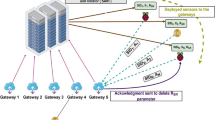Abstract
The Internet of Battlefield Things (IoBT) is an emerging application to improve operational effectiveness for military applications. The security of IoBT is one of the more challenging aspects, where adversaries can exploit vulnerabilities in IoBT software and deployment conditions to gain insight into their state. In this work, we look into the security of IoBT from the lens of cyber deception. First, we formulate the IoBT domain as a graph learning problem from an adversarial point of view and introduce various tools through which an adversary can learn the graph starting with partial prior knowledge. Second, we use this model to show that an adversary can learn high-level information from low-level graph structures, including the number of soldiers and their proximity. For that, we use a powerful n-gram based algorithm to obtain features from random walks on the underlying graph representation of IoBT. Third, we provide microscopic and macroscopic approaches that manipulate the underlying IoBT graph structure to introduce uncertainty in the adversary’s learning. Finally, we show our approach’s effectiveness through analyses and evaluations.
Access this chapter
Tax calculation will be finalised at checkout
Purchases are for personal use only
Similar content being viewed by others
References
Community detection for networkx. http://python-louvain.readthedocs.io
node2vec repository. https://github.com/aditya-grover/node2vec
Belkin, M., Niyogi, P.: Laplacian eigenmaps and spectral techniques for embedding and clustering. In: Proceedings of the NIPS (2002)
Cameron, L.: Internet of things meets the military and battlefield: connecting gear and biometric wearables for an IoMT and IoBT. https://www.computer.org/publications/tech-news/research/internet-of-military-battlefield-things-iomt-iobt
Cheswick, B.: An evening with berferd in which a cracker is lured, endured, and studied. In: Proceedings of the USENIX Conference (1992)
Erdos, P., Rényi, A.: On the evolution of random graphs. Publ. Math. Inst. Hung. Acad. Sci. 5(1), 17–60 (1960)
Gallagher, B., Eliassi-Rad, T.: Leveraging label-independent features for classification in sparsely labeled networks: an empirical study. In: Proceedings of the SNAKDD (2010)
Grover, A., Leskovec, J.: node2vec: scalable feature learning for networks. In: Proceedings of the ACM KDD (2016)
Henderson, K., et al.: It’s who you know: graph mining using recursive structural features. In: Proceedings of the ACM KDD (2011)
Kott, A., Swami, A., West, B.J.: The internet of battle things. IEEE Comput. 49(12), 70–75 (2016)
Leskovec, J., Krevl, A.: SNAP datasets: stanford large network dataset collection (2014). https://snap.stanford.edu/data/p2p-Gnutella04.html
Mikolov, T., Chen, K., Corrado, G., Dean, J.: Efficient estimation of word representations in vector space. arXiv preprint arXiv:1301.3781 (2013)
Mohaisen, A., Hollenbeck, S.: Improving social network-based sybil defenses by rewiring and augmenting social graphs. In: Kim, Y., Lee, H., Perrig, A. (eds.) WISA 2013. LNCS, vol. 8267, pp. 65–80. Springer, Cham (2014). https://doi.org/10.1007/978-3-319-05149-9_5
Pang, J., Zhang, Y.: DeepCity: a feature learning framework for mining location check-ins. arXiv preprint arXiv:1610.03676 (2016)
Perozzi, B., Al-Rfou, R., Skiena, S.: DeepWalk: online learning of social representations. In: Proceedings of the ACM KDD (2014)
Provos, N.: Honeyd-a virtual honeypot daemon. In: Proceedings of the DFN-CERT Workshop (2003)
Roweis, S.T., Saul, L.K.: Nonlinear dimensionality reduction by locally linear embedding. Science 290(5500), 2323–2326 (2000)
Spitzner, L.: The honeynet project: trapping the hackers. IEEE Secur. Priv. 99(2), 15–23 (2003)
Tang, J., Qu, M., Wang, M., Zhang, M., Yan, J., Mei, Q.: LINE: large-scale information network embedding. In: Proceedings of the WWW (2015)
Acknowledgement
This work is supported in part by NSF grant CNS-1809000 and NRF grant 2016K1A1A2912757.
Author information
Authors and Affiliations
Corresponding author
Editor information
Editors and Affiliations
Rights and permissions
Copyright information
© 2020 This is a U.S. government work and its text is not subject to copyright protection in the United States; however, its text may be subject to foreign copyright protection
About this paper
Cite this paper
Park, J., Mohaisen, A., Kamhoua, C.A., Weisman, M.J., Leslie, N.O., Njilla, L. (2020). Cyber Deception in the Internet of Battlefield Things: Techniques, Instances, and Assessments. In: You, I. (eds) Information Security Applications. WISA 2019. Lecture Notes in Computer Science(), vol 11897. Springer, Cham. https://doi.org/10.1007/978-3-030-39303-8_23
Download citation
DOI: https://doi.org/10.1007/978-3-030-39303-8_23
Published:
Publisher Name: Springer, Cham
Print ISBN: 978-3-030-39302-1
Online ISBN: 978-3-030-39303-8
eBook Packages: Computer ScienceComputer Science (R0)




